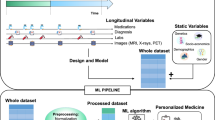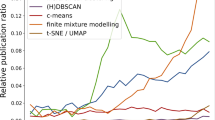Abstract
Introduction
One of the body fluids often used in metabolomics studies is urine. The concentrations of metabolites in urine are affected by hydration status of an individual, resulting in dilution differences. This requires therefore normalization of the data to correct for such differences. Two normalization techniques are commonly applied to urine samples prior to their further statistical analysis. First, AUC normalization aims to normalize a group of signals with peaks by standardizing the area under the curve (AUC) within a sample to the median, mean or any other proper representation of the amount of dilution. The second approach uses specific end-product metabolites such as creatinine and all intensities within a sample are expressed relative to the creatinine intensity.
Objectives
Another way of looking at urine metabolomics data is by realizing that the ratios between peak intensities are the information-carrying features. This opens up possibilities to use another class of data analysis techniques designed to deal with such ratios: compositional data analysis. The aim of this paper is to develop PARAFAC modeling of three-way urine metabolomics data in the context of compositional data analysis and compare this with standard normalization techniques.
Methods
In the compositional data analysis approach, special coordinate systems are defined to deal with the ratio problem. In essence, it comes down to using other distance measures than the Euclidian Distance that is used in the conventional analysis of metabolomic data.
Results
We illustrate using this type of approach in combination with three-way methods (i.e. PARAFAC) of a longitudinal urine metabolomics study and two simulations. In both cases, the advantage of the compositional approach is established in terms of improved interpretability of the scores and loadings of the PARAFAC model.
Conclusion
For urine metabolomics studies, we advocate the use of compositional data analysis approaches. They are easy to use, well established and proof to give reliable results.







Similar content being viewed by others
References
Aitchison, J. (2003). A concise guide to compositional data analysis. In CoDaWork’03. Universitat de Girona. Departament d’Informática i Matemática Aplicada.
Aitchison, J. (1986). The statistical analysis of compositional data. London: Chapman & Hall.
Aitchison, J., & Greenacre, M. (2002). Biplots of compositional data. Journal of the Royal Statistical Society, 51(4), 375–392.
Andersson, C., Munck, L., Henrion, R., & Henrion, G. (1997). Analysis of n-dimensional data arrays from fluorescence spectroscopy of an intermediary sugar product. Fresenius’ Journal of Analytical Chemistry, 359, 138–142.
Billheimer, D., Guttorp, P., & Fagan, W. (2001). Statistical interpretation of species composition. Journal of the American Statistical Association, 96(456), 1205–1214.
Bosco, M., Garrido, M., & Larrechi, M. (2006). Determination of phenol in the presence of its principal degradation products in water during a tio2-photocatalytic degradation process by three-dimensional excitation-emission matrix fluorescence and parallel factor analysis. Analytica Chimica Acta, 559, 240–247.
Brereton, R. (2009). Chemometrics for pattern recognition. Chichester: Wiley.
Bro, R. (1998). Multi-way analysis in the food industry—Models, algorithms and applications. PhD thesis, Universiteit van Amsterdam, The Netherlands.
Bro, R. (1997). Parafac. tutorial and applications. Chemometrics and Intelligent Laboratory, 38, 149–171.
Bro, R., & Smilde, A. (2003). Centering and scaling in component analysis. Journal of Chemometrics, 17(1), 16–33.
Carroll, J., & Chang, J. (1970). Analysis of individual differences in multidimensional scaling via an \(n\)-way generalization of Eckart-Young decomposition. Psychometrika, 35, 283–319.
Carter, B., Haverkamp, A., & Merenstein, G. B. (1993). The definition of acurate perinatal asphyxia. Psychometrika, 20(2), 287–304.
Chen, Y., Shen, G., Zhang, R., He, J., Zhang, Y., Xu, J., et al. (2013). Combination of injection volume calibration by creatinine and ms signals normalization to overcome urine variability in lc-ms-based metabolomics studies. Psychometrika, 85, 7659–7665.
Development Core Team, R. (2012). R: A language and environment for statistical computing. Vienna, Austria: R Foundation for Statistical Computing.
Di Palma, A., Gallo, M., Filzmoser, P., & Hron, K. (2015). A robust Candecomp/Parafac model for compositional data. Submitted.
Dieterle, F., Ross, A., Schlotterbeck, G., & Senn, H. (2006). Probabilistic quotient normalization as robust method to account for dilution of complex biological mixtures. Application in H-1 NMR metabolomics. Analytical Chemistry, 78, 4281–4290.
Dunn, W. B., Broadhurst, D., Begley, P., Zelena, E., Francis-McIntyre, S., Anderson, N., et al. (2011). Procedures for large-scale metabolic profiling of serum and plasma using gas chromatography and liquid chromatography coupled to mass spectrometry. Analytical Chemistry, 6(7), 1060–1083.
Eaton, M. (1983). Multivariate statistics. A vector space approach. New York: Wiley.
Egozcue, J., & Pawlowsky-Glahn, V. (2006). Simplicial geometry for compositional data. In Pawlowsky-Glahn, V., & Buccianti, A., (Eds.), Compositional data analysis in the geosciences: From theory to practice (pp. 145–160). Geological Society, London. Special Publications 264.
Egozcue, J., Pawlowsky-Glahn, V., Mateu-Figueras, G., & Barceló-Vidal, C. (2003). Isometric logratio transformations for compositional data analysis. Analytical Chemistry, 35(3), 279–300.
Engle, M. A., Gallo, M., Schroeder, K. T., Geboy, N. J., & Zupancic, J. W. (2014). Three-way compositional analysis of water quality monitoring data. Analytical Chemistry, 21(3), 565–581.
Filzmoser, P., & Hron, K. (2015). Robust coordinates for compositional data using weighted balances. In K. Nordhausen & S. Taskinen (Eds.), Modern nonparametric, robust and multivariate methods (pp. 167–184). Heidelberg: Springer.
Filzmoser, P., & Walczak, B. (2014). What can go wrong at the data normalization step for identification of biomarkers? Analytical Chemistry, 1362, 194–205.
Fung, E. T., & Enderwick, C. (2002). Proteinchip clinical proteomics: Computational challenges and solutions. Analytical Chemistry, 32, S34–S41.
Gallo, M. (2013). Log-ratio and parallel factor analysis: An approach to analyze three-way compositional data. In A. N. Proto, M. Squillante, & J. Kacprzyk (Eds.), Advanced dynamic modeling of economic and social systems (Vol. 448, pp. 209–221)., Studies in Computational Intelligence Springer: Heidelberg.
Giordani, P., Kiers, H., & Del Ferraro, M. (2014). Three-way component analysis using the R package ThreeWay. Analytical Chemistry, 57(7), 1–23.
Goodacre, R., Broadhurst, D., Smilde, A., Kristal, B., Baker, J., Beger, R., et al. (2007). Proposed minimum reporting standards for data analysis in metabolomics. Metabolomics, 3, 231–241.
Haglund, O. (2008). Qualitative comparison of normalization approaches in maldi-ms. Master of Science Thesis, Royal Institute of Technology, Stockholm, Sweden.
Harshman, R. (1970). Foundations of the parafac procedure: Models and conditions for an “explanatory” multimodal factor analysis. UCLA Working Papers in Phonetics, Vol.16, pp. 1–84.
Harshman, R., & Lundy, M. (1994). Parafac: Parallel factor analysis. Metabolomics, 18, 39–72.
Hron, K., Jelínková, M., Filzmoser, P., Kreuziger, R., Bednář, P., & Barták, P. (2012). Statistical analysis of wines using a robust compositional biplot. Talanta, 90, 46–50.
Hubert, M., Van Kerckhoven, J., & Verdonck, T. (2012). Robust parafac for incomplete data. Talanta, 26(6), 290–298.
Janečková, H., Hron, K., Wojtowicz, P., Hlídková, E., Barešová, A., Friedecký, D., et al. (2012). Targeted metabolomic analysis of plasma samples for the diagnosis of inherited metabolic disorders. Talanta, 1226, 11–17.
Kalivodová, A., Hron, K., Filzmoser, P., Najdekr, L., Janečková, H., & Adam, T. (2015). PLS-DA for compositional data with application to metabolomics. Talanta, 29, 21–28.
Karlíková, R., Široká, J., Jahn, P., Friedecký, D., Gardlo, A., Janečková, H., Hrdinová, F., Drábková, Z., and Adam, T. (2016). Atypical myopathy of grazing horses: a metabolic study. Under review.
Kiers, A. L. (2000). Towards a standardized notation and terminology in multiway analysis. Talanta, 14, 105–122.
Kolda, T., & Bader, B. W. (2009). Talanta, 51(3), 455–500.
Korhoňová, M., Hron, K., Klimčíková, D., Müller, L., Bednář, P., & Barták, P. (2009). Coffee aroma—Statistical analysis of compositional data. Talanta, 80, 710–715.
Kruskal, J. (1977). Three-way arrays: Rank and uniqueness of trilinear decomposition, with application to arithmetic complexity and statistics. Linear Algebra Applications, 18, 95–138.
Leibovici, D., & Sabatier, R. (1998). A singular value decomposition of k-way array for a principal component analysis of multiway data, pta-k. Linear Algebra Applications, 269, 307–329.
Martín-Fernández, J. A., Palarea-Albaladejo, J., & Olea, R. A. (2011). Dealing with zeros. In V. Pawlowsky-Glahn & A. Buccianti (Eds.), Compositional data analysis: Theory and applications (pp. 43–58). Chichester: Wiley.
Mateu-Figueras, G., & Pawlowsky-Glahn, V. (2008). A critical approach to probability laws in geochemistry. Mathematical Geosciences, 40(5), 489–502.
Mei, J., Alexander, J., Adam, B., & Hannon, W. (2001). Use of filter paper for the collection and analysis of human whole blood specimens. Mathematical Geosciences, 131, 1631–1636.
Najdekr, L., Gardlo, A., Mádrová, L., Friedecký, D., Janečková, H., Correa, E., et al. (2015). Oxidized phosphatidylcholines suggest oxidative stress in patients with medium-chain acyl-CoA dehydrogenase deficiency. Talanta, 139, 62–66.
Paatero, P., & Juntto, S. (2000). Determination of underlying components of a cyclical time series by means of two-way and three-way factor analytic techniques. Talanta, 14, 241–259.
Pawlowsky-Glahn, V., & Buccianti, A. (2011). Compositional data analysis: Theory and applications. Chichester: Wiley.
Pawlowsky-Glahn, V., & Egozcue, J. J. (2001). Geometric approach to statistical analysis on the simplex. Talanta, 15(5), 384–398.
Pawlowsky-Glahn, V., Egozcue, J., & Tolosana-Delgado, R. (2015). Modeling and analysis of compositional data. Chichester: Wiley.
Pearson, K. (1897). Mathematical contributions to the theory of evolution. on a form of spurious correlation which may arise when indices are used in the measurement of organs. In: Proceedings of the Royal Society of London, LX.
Pravdova, V., Boucon, C., de Jong, S., Walczak, B., & Massart, D. (2002). Three-way principal component analysis applied to food analysis: An example. Talanta, 462, 133–148.
Sauve, A., & Speed, T. (2004). Normalization, baseline correction and alignment of high-throughput mass spectrometry data. Proceedings of the genomic signal processing and statistics workshop, Baltimore, MO, USA, May 26–27, pages http://stat–www.berkeley.edu/users/terry/Group/publications/Final2Gensips2004Sauve.pdf.
Smilde, A., Bro, R., & Geladi, P. (2004). Multi-way analysis with applications in the chemical sciences. Chichester, UK: Wiley.
Templ, M., Hron, K., & Filzmoser, P. (2011). robCompositions: An R-package for robust statistical analysis of compositional data.
Tucker, L. (1966). Some mathematical notes on three-mode factor analysis. Psychometrika, 31, 279–311.
van den Berg, R. A., Hoefsloot, H. C. J., Westerhuis, J. A., Smilde, A. K., & van der Werf, M. J. (2006). Centering, scaling, and transformations: Improving the biological information content of metabolomics data. Psychometrika, 7, 142.
Waikar, S., Sabbisetti, V. S., & Bonventre, J. (2010). Normalization of urinary biomarkers to creatinine during changes in glomerular filtration rate. Kidney International, 78(5), 486–494.
Warracka, B., Hnatyshyna, S., Otta, K., Reilya, M., Sandersa, M., Zhanga, H., et al. (2009). Normalization strategies for metabonomic analysis of urine samples. Journal of Chromatography B, 877, 547–552.
Weintraub, A., Carey, A., Connors, J., Blanco, V., & Green, R. (2015). Relationship of maternal creatinine to first neonatal creatinine in infants<30 weeks gestation. Journal of Perinatology, Jan 15.:Epub ahead of print.
Compliance with Ethical Standards
Conflicts of interest
The authors confirm that they have no conflicts of interest.
Funding
This study was funded by the grant 15-34613L of the Czech Science Foundation (GA CR), the projects CZ.1.07/2.3.00/20.0170 and LO1304 of the Ministry of Education, Youth and Sports of the Czech Republic, grant LF_2016_014 by IGA MZČR NT12218, IGUP Olomouc and grant IGA_PrF_2016_025 of the Internal Grant Agency of the Palacký University in Olomouc. The authors gratefully acknowledge to MUDr. Lumír Kantor, Ph.D from Neonatal Department, University Hospital Olomouc, Olomouc, Czech Republic.
Ethical approval
All procedures performed in studies involving human participants were in accordance with the ethical standards of the institutional and/or national research committee and with the 1964 Helsinki declaration and its later amendments or comparable ethical standards.
Author information
Authors and Affiliations
Corresponding author
Rights and permissions
About this article
Cite this article
Gardlo, A., Smilde, A.K., Hron, K. et al. Normalization techniques for PARAFAC modeling of urine metabolomic data. Metabolomics 12, 117 (2016). https://doi.org/10.1007/s11306-016-1059-9
Received:
Accepted:
Published:
DOI: https://doi.org/10.1007/s11306-016-1059-9




